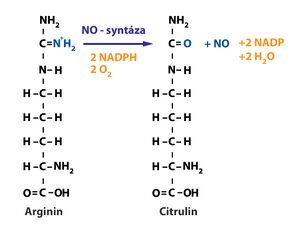Signaling NO (Nitric Oxide)
NO (nitric oxide) is a gas acting as a local mediator in many tissues. It only acts locally because it only exists for a very short time (half-life 5-10 s[1]). It reacts with oxygen and water to form nitrates and nitrites. NO has a vasodilation effect on smooth muscle vessels. Macrophages and neutrophil granulocytes produce NO during inflammatory reactions and serve as a cytotoxic tool for them. Neurons use NO as a neurotransmitter.
Synthesis of NO[edit | edit source]
It is produced by a group of enzymes called NO synthases (NOS). NOS molecules contain a number of cofactors and prosthetic groups - FMN, FAD, non-heme iron, tetrahydrobiopterin and heme[2]. It comes from the amino acid arginine.
NO synthases[edit | edit source]
There are several isoforms of NOS.
- Constitutive NOS - Ca2+ dependent (activated by Ca2+):
- Neuronal NO-synthase (nNOS),
- Endothelial NO-synthase (eNOS).
- Inducible (also inducible) NOS (iNOS) – Ca2+ independent, induced by external signals, expressed by cells of the immune system and endothelium.
General mechanism of action of NO[edit | edit source]
NO does not act on the cell that produces it, but on surrounding cells.
- The First cell synthesizes NO, which then diffuses cytoplasmic membrane into the other cell.
- The second cell receives NO, which binds to soluble guanylate cyclase in it, causing an increase in cGMP concentration. An increased concentration of cGMP starts a cascade of events that results in the dilation of the given cell. The resulting effect is vasodilation in the vascular bed.
The role of NO in the relaxation of smooth muscle in the vascular wall[edit | edit source]
Endothelial cells constantly produce a small amount of nitric oxide that keeps blood flowing through the vessels. However, if vasodilation is to occur, endothelial cells release NO in response to nerve stimulation. NO freely passes through the membrane (diffuses) from the endothelial cell, in which it is synthesized, into the smooth muscle cell. Inside the smooth muscle cell, NO binds to the enzyme soluble guanylate cyclase located in the cytosol. Subsequently, the formation of cGMP occurs from GTP. cGMP is a second messenger that activates protein kinase G, and through the phosphorylation of various proteins, the intracellular concentration of Ca2+ will decrease and the smooth muscle cell will relax.
Role of NO in erection[edit | edit source]
NO is released by nerve endings in the penis and causes blood vessels to dilate, which is responsible for an erection. When sexual arousal decreases, cGMP is rapidly broken down to GMP by the action of cGMP-specific phosphodiesterase. Viagra and related drugs slow the breakdown of cGMP and thus maintain an erection.[1]
Links[edit | edit source]
Related Articles[edit | edit source]
Source[edit | edit source]
- GREY, Prof. MD Alex. Signal transduction III [lecture for subject Medical chemistry and biochemistry 1, specialization Biochemistry, 1.LF UK]. Prague. 1/13/2016.
References[edit | edit source]
References[edit | edit source]
- MATOUŠ, Bohuslav. Basics of medical chemistry and biochemistry. 1. edition. Galen, 2010. 540 pp. ISBN 978-80-7262-702-8.
- BRUCE, Alberts – BRAY, D – JOHNSON, A. Fundamentals of Cell Biology. 1. edition. Espero Publishing, 1998. 630 pp. ISBN 80-902906-0-4.
- KOOLMAN, Jan – RÖHM, Klaus-Heinrich. Color Atlas of Biochemistry. 1. edition. Grada, 2012. 512 pp. ISBN 978-80-247-2977-0.


